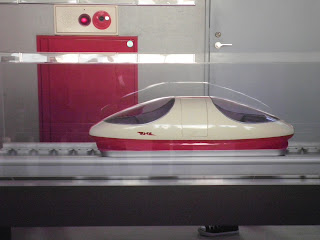On the last day of the program, we were brought on a study trip to Hitachi and RTRI as part of the Nanoscience course. Although the research that these two corporations deal with is not so related to nanoscience, the trip still gave us a holistic and interesting perspective on the development of science and research in an industrial setting.
Due to the no-photos policy in Hitachi, I'm not able to share any pictures of the research labs. Previous to the trip, my only perception of Hitachi is that it is a manufacturer of air-conditioners, computers, televisions and other home electronic appliances. However, it turns out that this view is too limited. From the study visit, I learned that the corporation engages in technological research and development in a myriad of disciplines, and is on the way to develop advanced equipments such as personal identification systems based on finger veins, and MRI (Magnetic Resonance Imaging) machines.
Next, we went on to visit RTRI (Railway Technical Research Institute), the technical research company under the Japanese Railways group of companies. JR (Japanese Railways) operates a large proportion of intercity rail service, including the well-known Shinkansen, as well as local commuter rail service.
The Large-Scale Rainfall Simulator can test for train conditions and performances during harsh weather. Different levels of rainfall can be simulated, and we were allowed to experience the top level, with umbrellas provided of course. This is a nice change from the hot and humid Tokyo weather that day.
The two photos above show the different Maglev models developed, the top one being the original/primitive model, and the bottom one being the modern model. Maglev trains work on magnetic levitation principles, as compared to mechanical methods like wheels and bearings. Such trains can reach high speeds of up to 500km/h. A Wikipedia search states that the highest recorded speed of a Maglev train is 581/h or 361mph, and is achieved in Japan by JR Central's superconducting Maglev system in 2003. This is 6km/h or 3.7mph faster than the conventional wheel-rail speed record, set by TGV, France's high-speed rail service.





No comments:
Post a Comment